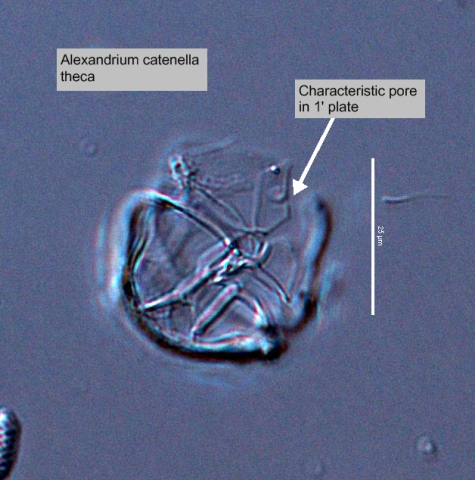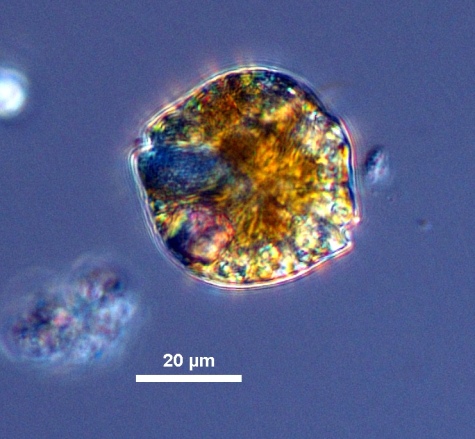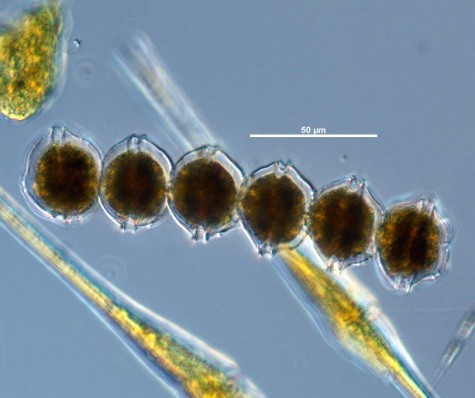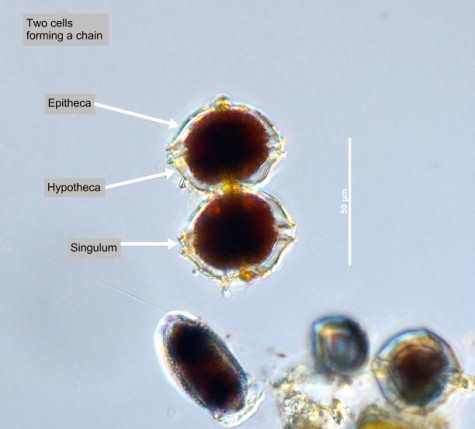



|




|
Synonym(s)
Protogonyaulax catenella (Whedon and Kafoid) Taylor 1979
Gessnerium catenellum (Loeblich III et Loeblich) Taylor 1979
(Horner 2002, Smithsonian 2012)
Classification
(Guiry and Guiry 2012)
Lifestyle
Heterothallic
(hetero- different; thallos green shoot or twig) Describing an organism that has male and female reproductive parts on different parts of the organism.
(heterothallism) and asexually by CloseBinary fission
A form of asexual reproduction where one cell divides into two identical cells. All prokaryotes and some eukaryotes reproduce in this manner. Compare with mitosis, where the nucleus must also divide, adding an extra step to the process.
binary fission (Olenina and Olenin 2006). It has a life cycle with various stages: motile vegetative cells, CloseHaploid
Containing one set of chromosomes (1n, where n is the number of unique chromosomes). For example, human gametes (sperm and eggs) are haploid and have 23 unique chromosomes (1n = 23). See also Diploid and Ploidy.
haploid CloseGamete
A reproductive cell (sperm or ovum) that can combine with another reproductive cell to create a new individual.
gametes, CloseDiploid
Containing two identical sets of chromosomes (2n, where n is the number of unique chromosomes). For example, humans are diploid and have 23 unique chromosomes (n = 23), so most cells in your body each have 46 chromosomes (2n = 46). Gametes (sperm and eggs) are haploid (1n = 23). See also Haploid and Ploidy.
diploid zygotes, resting CloseCyst
"A thick-walled dormant cell" (Horner 2002).
cysts and temporary cysts (Olenina and Olenin 2006). Its resting cysts are colourless ellipsoid cells with round ends covered by a smooth wall (Smithsonian 2012). The resting cysts are 38 - 56 μm long and 23 - 32 μm wide (Smithsonian 2012).Description
Nucleus
(plural: nuclei) In eukaryotic cells, a membrane-bound organelle that contains the cell's genetic information; the nucleus controls the activities of the cell by controlling gene expression.
nucleus (MSIP 2012). The CloseApical
(axis, spine) The region of the apex or point. Refers to the most anterior point or region of the cell (HPP 2003).
apical pore plate has the characteristic fishhook-shaped CloseForamen
(plural: foramina) The space within an areolation or hole. Often used to describe features on diatom frustules and dinoflagellate thecae (Hasle and Syvertsen 1996).
foramen (Montagnes 2006). The CloseHypotheca
In thecate dinoflagellates, the posterior part of a dinokont cell above the cingulum. The equivalent of a hypocone for naked dinoflagellates.
hypotheca is roughly equal in size to the CloseEpitheca
In thecate dinoflagellates, the anterior part of a dinokont cell above the cingulum. The equivalent of epicone for naked dinoflagellates.
epitheca (Smithsonian 2012).Measurements
Width: 17 - 44 μm
(Smithsonian 2012, Montagnes 2006)
Similar species
Ventral
Relating to the underside of an organism; abdominal.
ventral pore (Smithsonian 2012). A. catenella can occur in short chains while A. tamarense is solitary (Smithsonian 2012).Harmful effects
Habitat
Distribution
A. catenella is found in cold temperate coastal waters (Smithsonian 2012). It has been observed off the west coast of North America, Chile, Argentina, western South Africa and Japan (Smithsonian 2012). Generally, populations of A. catenella have been found in the North Pacific, South Pacific and South Atlantic (Horner 2012). Blooms that are restricted to harbours and other constricted zones have been seen in the Mediterranean Sea (Laabir et al. 2011).
A. tamarense cells have been found in Puget Sound in late May and early June (Dyhrman et al. 2010).
Growth conditions
Bloom characteristics
References
Dyhrman, S. T., Haley, S. T., Borchert, J. A., Lona, B., Kollars, N. and Erdner, D. L. 2010. Parallel Analyses of Alexandrium catenella Cell Concentrations and Shellfish Toxicity in the Puget Sound. American Society for Microbiology. 76(14): 4647-4654.
Fuentes, C., Clement, A. and Aguilera, A. 2008. Summer Alexandrium catenella Bloom and Impact on Fish Farming, in the X1 Aysen Region, Chile. International Society for the Study of Harmful Algae and Intergovernmental Oceanographic Commission of UNESCO. Copenhagen.
Guiry, M. D. and Guiry, G. M. 2012. A. catenella (Whedon and Kafoid) Balech 1985. http://www.algaebase.org/search/species/detail/?species_id=40281. Accessed 22 Jan 2012.
Hallegraff, G. M. 1991. A review of Harmful Algal Blooms and their Apparent Global Increase. Phycologia. 32(2): 79-99.
Horner, R. A. 2002. A Taxonomic Guide To Some Common Phytoplankton. Biopress Limited, Dorset Press, Dorchester, UK. 200.
Laabir, M., Jauzein, C., Genovesi, B., Masseret, E., Grzebyk, D., Cecchi, P., Vaquer, A., Perrin, Y. and Collos, Y. 2011. Influence of temperature, salinity and irradiance on the growth and cell yield of the harmful red tide dinoflagellate Alexandrium catenella colonizing Mediterranean waters. Journal of Plankton Research. 33(10): 1550-1563.
Montagnes, D. 2006. Guide to Harmful Phytoplankton. University of Liverpool, UK. http://www.liv.ac.uk/hab/Data%20sheets/a_cate.htm. Accessed 22 Jan 2012.
Olenina, I. and Olenin, S. 2006. Delivering Alien Invasive Species Inventory for Europe. http://www.europe-aliens.org/pdf/Alexandrium_catenella.pdf. Accessed 27 Jan 2012.
Smithsonian Institution. 2012. A. catenella (Whedon and Kafoid) Balech 1985. http://botany.si.edu/references/dinoflag/Taxa/Acatanella.htm. Accessed 22 Jan 2012.
